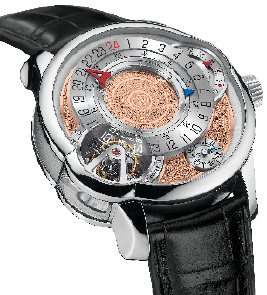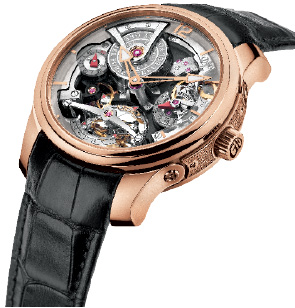- Home
- Media Kit
- Current Issue
- Past Issues
- Ad Specs-Submission
- Ad Print Settings
- Reprints (PDF)
- Photo Specifications (PDF)
- Contact Us

![]()
ONLINE

$300,000 and Up
Editors' Note
From 1987 to 1992, Stephen Forsey specialized in antique clock restoration and after-sales service. He became head of the prestigious Watch Restoration department at Asprey’s in London in 1988 and left in 1990 to attend the WOSTEP School in Neuchatel. He joined Robert Greubel’s team at Renaud & Papi in 1992, left in 2001 and, that year, cofounded Complitime with Robert Greubel, to develop and craft complicated movements for prestigious brands. In 2004, he cofounded Greubel Forsey with Robert Greubel. He grew up in St. Albans, England.
Company Brief
Greubel Forsey is a high-end watch company known for creating extraordinarily complicated timepieces entirely by hand. The company only produces about 100 watches per year which, starting at around $300,000, are the most expensive non-diamond-embellished watches on the market. In November, Greubel Forsey’s Double Tourbillon Technique won the “Oscar” of the complicated watch world. Greubel Forsey (www.greubelforsey.com) is 20 percent owned by Richemont Group.

Invention Piece 3 platinum case
Would you give an overview of the history of Greubel Forsey and what you saw in the market that inspired you to create the brand?
Greubel Forsey was founded by two watchmakers: Robert Greubel and myself. We met while we were working at Renaud & Papi, which became Audemars Piguet, in Switzerland.
During the ’90s, we worked together on a number of different high-complication projects until 1999, when we realized we shared a similar vision of where mechanical watch-making might go. We were working on R&D projects for other companies, on a specific mechanism called the tourbillon. We wanted to work on the system and find a real new application for the wristwatch; there were many possibilities that had never been explored before. This gave us the base to say, we can make a small series of handmade, hand-finished timepieces, which we felt sure astute collectors would be interested in and hopefully share with us in this adventure.
So it took from 1999 to 2004 before we launched our first watch from Greubel Forsey. In April 2004, we launched the Greubel Forsey Double Tourbillon 30 degrees at Baselworld in Switzerland. We had our very first few watches that were finished and tested, which would be able to deliver if we could find clients for it.
Fortunately, our assessment and our vision was shared by different clients and we delivered the very first timepieces to the U.S. and Asia. We then started to build a very selective network of partners, ambassadors, and retailers around the world.

Double Tourbillon Technique 5N red gold case
Would you talk about the number of watches you make and how distribution channels have developed?
The hand-finishing is a key element of a Greubel Forsey watch; there are between 350 and 500 hours of hand-finishing in the components of the movement. The components are individually reworked by hand once they’ve been machined using modern, precise technology. So we’re only able to make a very small number of timepieces.
After the first three years, when we were looking at between 20 and 25 timepieces a year total, we were able to invest more energy and resources toward building a team. So since 2007, we have been able to increase our model range, adding other timepieces. For 2010, we will be able to produce between 100 and 110 timepieces for the whole year for the whole world. We have a team of 65 people at our new facility, which we installed the end of summer 2009.
We are working with about 35 retailers around the world today. And they’re a very important part of our mission because they’re ambassadors. Also, with such a small number of watches, we’re able to travel and visit them, and to do VIP presentations for clients one-on-one, which is unique.
Will your number of pieces grow in the future, or will the collection remain relatively consistent?
For us, it’s not the quantity or volume. Mr. Greubel and myself want to maintain our R&D work, looking at new mechanisms and the highest levels of craftsmanship. This limits the number of timepieces we can do. We’re talking a maximum of 110 pieces each year. We’re not looking to capitalize on what we’ve done by putting in 2,000 or 5,000 pieces.
At your price point, the perception is that, these are collector’s pieces, not necessarily watches you wear. Are you surprised at the use these watches have gotten?
We knew that up until the mid- to late-’90s, many watch collectors would rarely use their complicated watches because the level of complexity of the mechanism meant they could be quite fragile. But for Robert and myself, it was important that it be useable, because we wanted people to enjoy the technology, the finishing, and the whole adventure with us.
So we put a lot of energy into making our watches as reliable as possible. We shock-test them and subject them to hot and cold at our in-house laboratory.
We’re very pleased to see the client who buys a Greubel Forsey timepiece be happy to wear his watch. After six years, we’ve had the first few pieces coming back for after-sales service, and for some, you can see by the condition of the case that they’ve been worn very often. This means the watch is reliable and has brought pleasure, and that is the best compliment.•